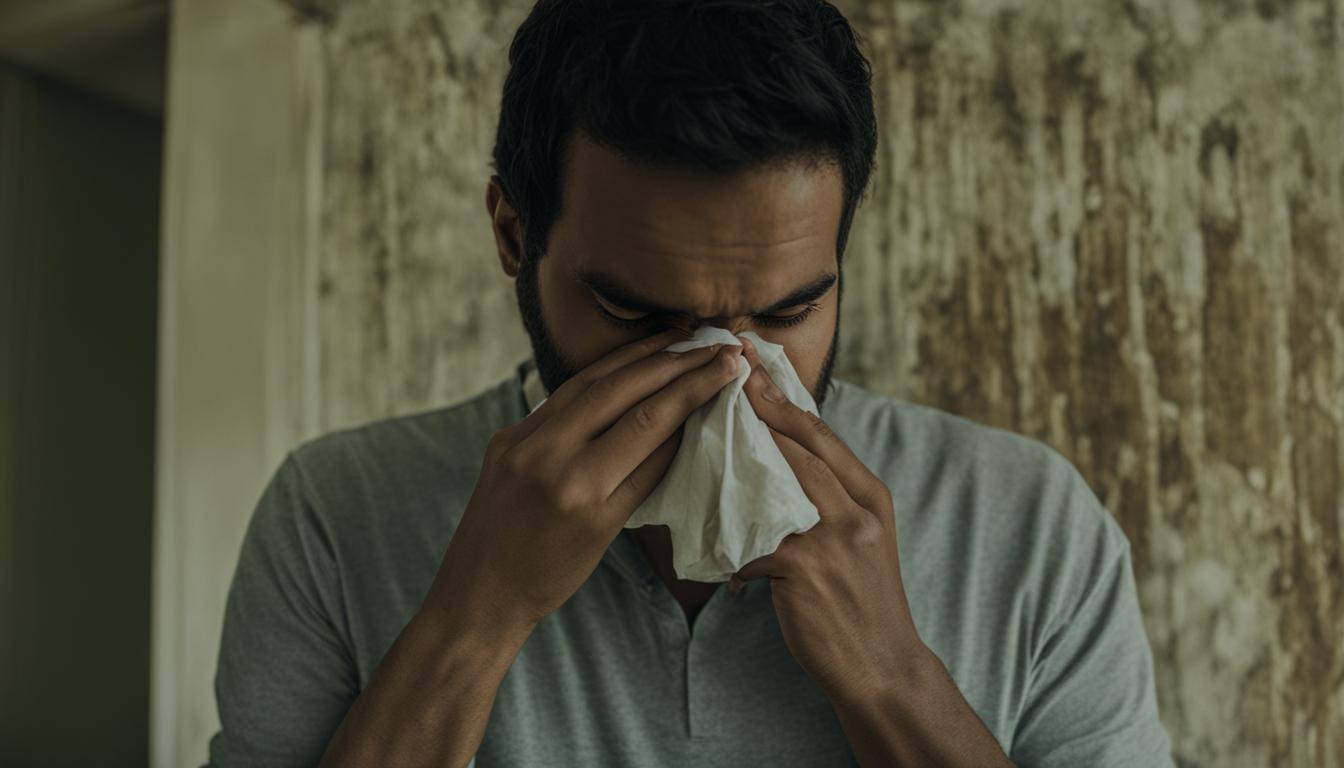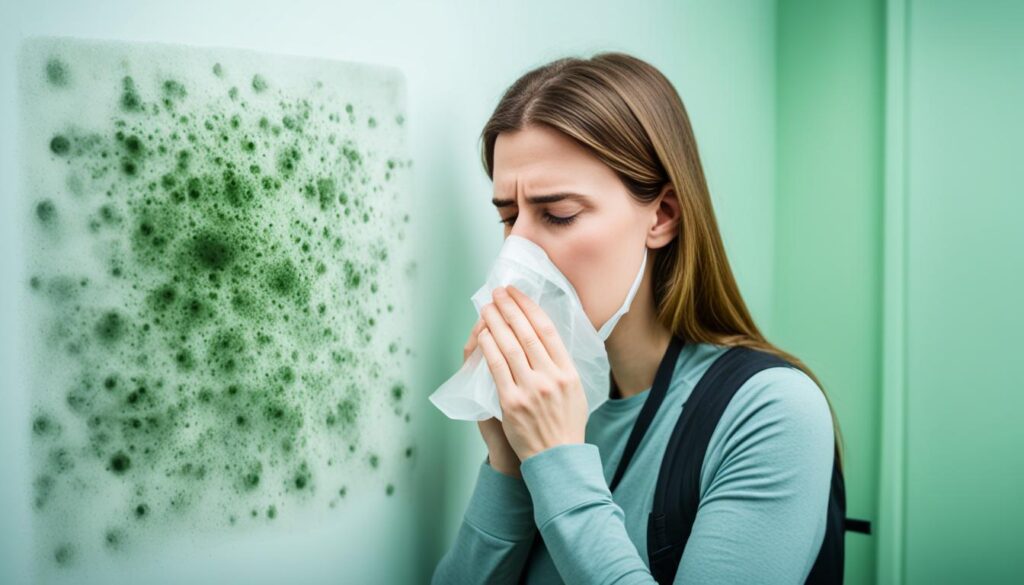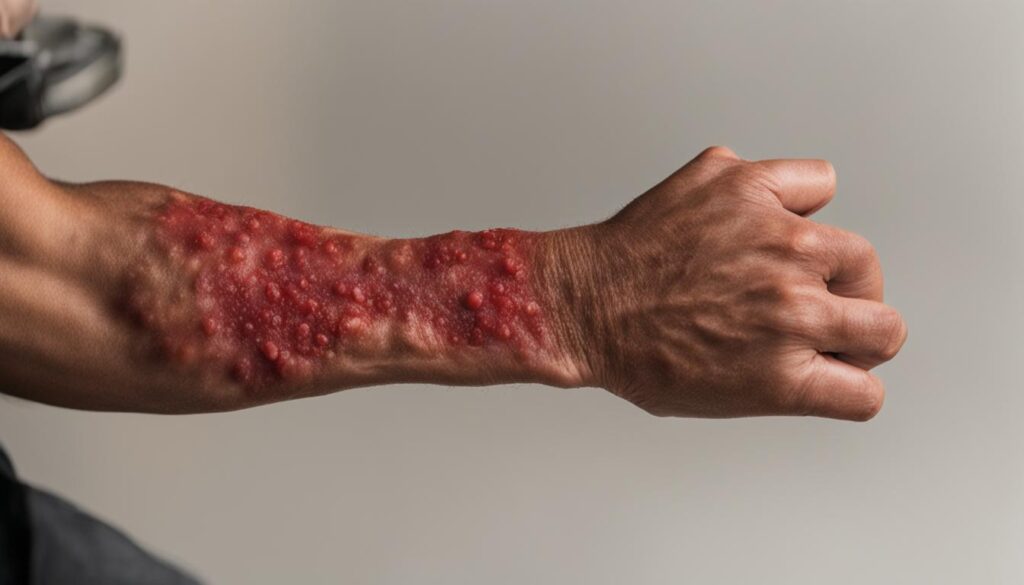
Recognizing Symptoms of Mold Allergy – Essential Guide
Are you experiencing unexplained symptoms that seem to persist no matter what you do? It’s possible that you may be suffering from a mold allergy. Mold, a common household problem, can trigger a range of health issues for individuals who are sensitive to it. Recognizing the symptoms of mold allergy is crucial in order to take appropriate measures and protect your health.
Key Takeaways:
- Symptoms of mold allergy can range from respiratory problems to skin reactions.
- Common signs of mold allergy include sneezing, coughing, and itchy eyes.
- Long-term mold exposure can lead to fatigue, headaches, and difficulty concentrating.
- A skin rash may also develop as a result of mold allergy.
- If you suspect a mold allergy, seek medical attention and consider professional mold assessments.
Common Reactions and Signs of Mold Allergy
Individuals with mold allergies may experience a range of common reactions and signs when exposed to mold in their environment. These reactions can manifest in various ways, affecting different parts of the body. Recognizing these symptoms is crucial in identifying and managing mold allergies effectively.
Respiratory Symptoms
One of the most common manifestations of mold allergies is respiratory symptoms. When exposed to mold spores, individuals may experience:
- Sneezing
- Coughing
- Nasal congestion
- Runny or itchy nose
- Postnasal drip
These symptoms resemble those of other respiratory conditions, such as the common cold or seasonal allergies. However, if they persist or worsen in damp or moldy environments, it may indicate an allergic reaction to mold.
Skin and Eye Reactions
In addition to respiratory symptoms, mold allergies can also manifest in skin and eye reactions. These include:
- Red, itchy, or watery eyes
- Skin rashes or hives
- Itchy skin
These reactions occur when individuals come into direct contact with mold or inhale mold spores. The severity of these symptoms can vary depending on the individual’s sensitivity to mold.
Mold Symptoms in the Home
Mold thrives in damp and poorly ventilated areas, such as bathrooms, basements, and kitchens. The presence of mold in the home can contribute to the onset or worsening of mold allergy symptoms.
To identify possible mold-related symptoms in your home, look out for:
- Visible mold growth on walls, ceilings, or other surfaces
- Damp or musty odor
- Water stains or discoloration on walls or ceilings
- Warping or peeling wallpaper or paint
If you suspect mold growth in your home and experience persistent allergy symptoms, it is essential to address the issue promptly to minimize health risks.
Mold allergies can significantly impact an individual’s quality of life. By recognizing the common reactions and signs, you can take effective measures to mitigate exposure, manage symptoms, and create a healthier living environment.
Next, we will delve deeper into the symptoms of mold exposure over an extended period, including long-term health effects and the importance of seeking medical attention if symptoms persist.
Understanding Mold Exposure Symptoms
When individuals are exposed to mold for an extended period, it can have significant impacts on their health. The symptoms of mold exposure can vary depending on the individual’s sensitivity and the duration and intensity of the exposure. In this section, we will explore the long-term health effects associated with chronic mold exposure and the importance of seeking medical attention if these symptoms persist.
A key symptom of chronic mold exposure is fatigue. Individuals may experience persistent feelings of tiredness and low energy levels, even after getting adequate rest. This fatigue can interfere with daily activities and reduce overall productivity.
Headaches are another common symptom experienced by those exposed to mold for an extended period. These headaches may be frequent and intense, affecting concentration and causing discomfort. It is essential to identify the underlying cause of the headaches to effectively manage them.
Difficulty concentrating is a significant challenge for individuals exposed to mold for a prolonged time. They may struggle to focus, retain information, and perform tasks that require mental clarity. This cognitive impairment can impact work, school, and overall quality of life.
Other symptoms of chronic mold exposure include dizziness, respiratory issues, and skin irritations. These symptoms can further complicate an individual’s well-being and may require comprehensive medical evaluation.
If you or someone you know is experiencing these symptoms persistently and suspects mold exposure as the cause, seeking medical attention is crucial. A healthcare professional can assess the symptoms, perform relevant tests, and develop an appropriate treatment plan.
Next, we will focus on a specific aspect of mold allergies – recognizing mold allergy skin rash and how to manage it effectively.

| Mold Exposure Symptoms | |
|---|---|
| Fatigue | Tiredness and low energy levels |
| Headaches | Frequent and intense headaches |
| Difficulty Concentrating | Impaired focus and cognitive function |
| Dizziness | Feeling lightheaded or unsteady |
| Respiratory Issues | Coughing, wheezing, or shortness of breath |
| Skin Irritations | Rashes, itching, or redness |
Recognizing Mold Allergy Skin Rash
When it comes to mold allergies, the impact on the skin should not be overlooked. Mold allergy skin rashes can occur as a result of exposure to mold spores in the environment. These rashes can vary in appearance and characteristics, making it essential to recognize and differentiate them from other skin conditions.
One common type of mold allergy skin rash is known as allergic contact dermatitis. This rash typically appears as red, itchy patches on the skin. The affected areas may also develop blisters or become swollen. It’s important to note that this type of rash occurs when the skin comes into direct contact with mold or mold-infested materials.
In some cases, individuals with mold allergies may experience hives, which are raised, itchy bumps that can appear anywhere on the body. These hives can be triggered by exposure to mold spores and may come and go quickly or persist for longer periods.
Another skin reaction associated with mold allergies is known as atopic dermatitis or eczema. This condition can cause dry, red, and itchy patches on the skin, often in areas prone to moisture, such as the hands, face, and folds of the skin. Mold exposure can exacerbate existing eczema symptoms or trigger new flare-ups.
To effectively manage mold allergy skin rashes, it’s crucial to identify and address the underlying cause of the allergic reactions. This includes minimizing exposure to mold by maintaining a clean and dry environment, using dehumidifiers in damp areas, and promptly addressing any water leaks or moisture issues. Additionally, individuals with mold allergies should consider wearing protective clothing and gloves when handling materials that may harbor mold.
“Recognizing and managing mold allergy skin rashes is vital for individuals with mold allergies. By taking proactive steps to reduce exposure and practicing good hygiene, it is possible to alleviate symptoms and improve overall skin health.”
Tips for Managing Mold Allergy Skin Rashes
| Tip | Description |
|---|---|
| Keep the environment clean and dry | Regularly clean and vacuum areas prone to mold growth. Ensure proper ventilation to prevent moisture buildup. |
| Use dehumidifiers | Reduce humidity levels in damp areas of the home, such as basements or bathrooms, to discourage mold growth. |
| Address water leaks promptly | Fix any water leaks or plumbing issues to prevent mold from thriving and spreading. |
| Wear protective clothing | When handling materials that may contain mold, wear long sleeves, gloves, and masks to minimize direct contact. |
| Avoid prolonged exposure to damp environments | Limit time spent in areas with high humidity or water damage, such as basements or areas affected by flooding. |
| Consult a dermatologist | If you develop persistent or severe skin rashes, seek medical advice for proper diagnosis and treatment. |

Conclusion
In conclusion, recognizing and addressing symptoms of mold allergy is crucial for maintaining a healthy living environment. Whether it’s sneezing, coughing, skin rashes, or respiratory issues, being aware of the signs can help you take timely action to protect yourself and your loved ones.
By understanding the common reactions and signs of mold allergy, you can identify potential mold problems in your home and take the necessary steps to address them. It’s also important to be aware of the symptoms that may arise from prolonged mold exposure, such as fatigue, headaches, and difficulty concentrating.
If you experience any symptoms of mold allergy, it’s recommended to reach out to a professional mold assessment and remediation service. Fix Mold Miami, Florida’s Highest Rated In Mold Assessments, Prevention, and Remediation, offers top-quality services to help you identify and eliminate mold issues in your home.




